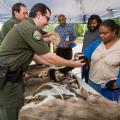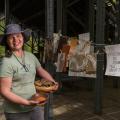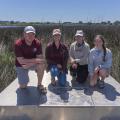Hardy Palms and Cycads for Mississippi
Palms and cycads are well-suited to the subtropical climate of coastal Mississippi. With bold linear trunks and exotic foliage, these plants provide an air of tropical lushness in the garden.
Though similar in appearance, palms are actually different than cycads. Palms are angiosperms, which mean plants that form seeds within a fruit. Cycads are gymnosperms which are plants that form naked seeds.
Palms can be used in a variety of ways in the landscape. From the tall cabbage palmettos that can reach 40 feet in height to the dwarf palmetto that is more shrub-like at 4-6 feet, palms are used in street plantings, shrub borders, and as courtyard specimens. Palms have either pinnate foliage (feathery) or palmate (fan-shaped).
Hardiness zones
The primary consideration when selecting palms and cycads in Mississippi is climate. Most palm types are not cold hardy and are best suited to the southern portions of the state, however there are a few cool-tolerant species. Check the USDA Hardiness zone for the area where you live. In the northern area of the state, zone 7 means annual minimum temperatures between 0 and 10 degrees Fahrenheit. Zone 8 is 10 to 20 degrees, and zone 9 is 20 to 30 degrees. You will have less concern for winter damage or plant loss when you select palm species that are best suited for your plant zone. Remember that in addition to low temperatures - that the duration of the cold period, the daytime high temperatures, the amount of sunlight and wind, site microclimates, and the plant's general health, age, and size can all affect winter survival.
Care and Planting
In the correct climate, palms and cycads are relatively easy to grow. In general, they will perform best in fertile well-drained soils and in full sunlight for most of the day. Once established, palms require little care and maintenance.
Palms and cycads may be planted at any time of the year, but the warm rainy summer months are best. Dig the hole for the palm several inches wider than the root ball. The depth should be the same height as the container, or where the previous soil line is on the trunk if it is bareroot. Bareroot palms should be planted quickly after being dug and roots should not be allowed to dry. It is not recommended to add soil amendments for palms, but instead to backfill with the original soil. Tamp the soil firmly in the planting hole and water thoroughly to remove air pockets. Mulch around the root zone with several inches of organic material, such as bark or straw, to conserve soil moisture and reduce weed competition. Large palms may need to be braced to remain stable the first year after planting. Do not drive nails into the palm trunk; use rope or insulated collars instead.
Newly planted palms should be watered daily for the first few weeks and frequently from then on until establishment. Fertilizer applications are not necessary until 3 to 4 months after planting. In general, it is recommended to fertilize palms twice yearly, in mid-April and mid-June, with a 15-5-10 fertilizer or similar combination.
Most palms are free of pests, but some insect problems include scale, caterpillars, mealybugs, and beetles. Leaf spots may occur periodically, but usually do not injure the plants. Contact your County Extension Director for identification and recommended controls.
Hardy Palm and Cycad Types
Winter palm damage primarily depends upon the severity and length of cold. The first signs of damage will occur with the leaves which will brown and die. The roots will often tolerate temperatures several degrees cooler than the foliar damage. In other words, if the leaves die back from cold, there is a chance it will re-sprout when the temperatures warm in spring. Trim back any dead leaves before new leaf emergence in spring.
Below are is list of hardy palm and cycad types suitable for growing in Mississippi, including their general plant descriptions, and their recorded absolute minimum temperature tolerances (Source: Southeastern Palm Society).
SHORT CLUMPING PALMS
(under 8' in height)
Dwarf Palmetto (Sabal minor)
This dwarf palm has fan-shaped foliage and can reach four to six feet in height. It is a shrub that is native to the Gulf Coastal Plain and is very tolerant of soil and sunlight conditions. Dwarf palmetto may exhibit leaf damage at around 5 degrees Fahrenheit, and is hardy to -5 degrees.
Needle Palm (Rhapidophyllum hysterix)
Needle palm is native to the southeastern United States and can grow up to eight feet in height. It has palmate leaves, and spines that form around the trunk of the plant. This handsome shrub is easy to grow and is reported to be hardy to -10 degrees Fahrenheit.
Saw Palmetto (Serenoa repens)
This shrubby palm can reach five to six feet tall and occasionally forms a trunk. It is native to the southeastern United States and is tolerant of a wide range of conditions. Saw palmetto exhibits damage at 10 degrees Fahrenheit and is tolerant of up to 0 degrees.
Sago (Cycas revoluta)
This species is the hardiest of the cycads and is suitable to zone 9. It has a slow rate of growth and features a dark green pinnate-leaf form. Leaf damage occurs around 20 degrees Fahrenheit and it will tolerate up to 10 degrees.
MEDIUM SIZE PALMS
(8' to 30')
Windmill Palm (Trachycarpus fortunei)
This is an easy to grow palm that can reach up to 30 feet in height. It has a fan-type foliage, and the thin trunk is covered with a fiber. Leaf damage occurs on windmill palms at 5 degrees Fahrenheit and will survive up to minus five degrees.
Jelly Palm (Butia capitata)
This hardy palm is native to Brazil and is very tolerant of a variety of soil conditions. It has pinnate leaves that form on a short thick trunk. It shows damage at 15 degrees, but it is hardy to 5 degrees Fahrenheit.
Mediterranean Fan Palm (Chamaerops humilis)
This clumping palm has fan-shaped foliage and can reach up to twenty feet in height. It will form several trunks and has relatively slow growth. Leaf damage occurs around 15 degrees, but will tolerate up to 5 degrees Fahrenheit.
LARGE PALMS
(over 30')
Cabbage Palm (Sabal palmetto)
This large palm is native to the Gulf Coast and can reach up to 40 feet. It shows leaf damage at 10 degrees and will tolerate temperatures to 0 degrees Fahrenheit.
California Fan Palm (Washingtonia filifera)
This large palm can grow to 40 feet tall. It has tall slender trunks that are topped with a broad crown of fan-shaped leaves. The leaves will brown at 15 degrees Fahrenheit, but it will tolerate temperatures to ten degrees.
Publications
News
An underserved community spent a day enjoying the outdoors at the Sam D. Hamilton Noxubee National Wildlife Refuge in early May as Mississippi State University Extension Service personnel hosted 20 adult residents of care homes.
Jim McAdory, MSU Extension agent in Winston County, coordinated the May 1 event with help from several other Extension agents and U.S. Fish and Wildlife Service staff. The goal was to allow this population to experience the outdoors, complete with a hot dog lunch at the end of the event.
PICAYUNE, Miss. -- School groups, nature enthusiasts and the public can enjoy two fun-filled days of exciting, hands-on learning about the environment, ecosystems, wildlife and insects at the Mississippi State University Crosby Arboretum in Picayune. BugFest offers insect-related displays, interactive exhibits, games and crafts. Biologists, naturalists, entomologists and other experts from Mississippi, Louisiana and Alabama will host booths and give presentations on butterflies, bats, caterpillars, beetles, crayfish, ladybugs, hissing cockroaches, dancing praying mantises, native and exotic arthropods and more.
Two conservation camps this summer offer students in grades six through 12 the opportunity to gain hands-on experience in wildlife science, outdoor recreation and conservation careers. Conservation Camp 2022 has a residential edition June 5-8 for rising eighth through 12th graders. The day camp edition is June 13-15 for rising sixth through eighth graders.
Success Stories
More than 80 grade-school students from Choctaw Tribal Schools visited Mississippi State University in March to participate in Choctaw Preview Day.
Robin Whitfield, who gave the child the paper, stands awestruck, watching her friend’s daughter use the flower to draw and color on the page.
Mississippi State University and partners have been awarded a grant of nearly $6.6 million from the National Fish and Wildlife Federation for shoreline restoration work on the Gulf Coast.





